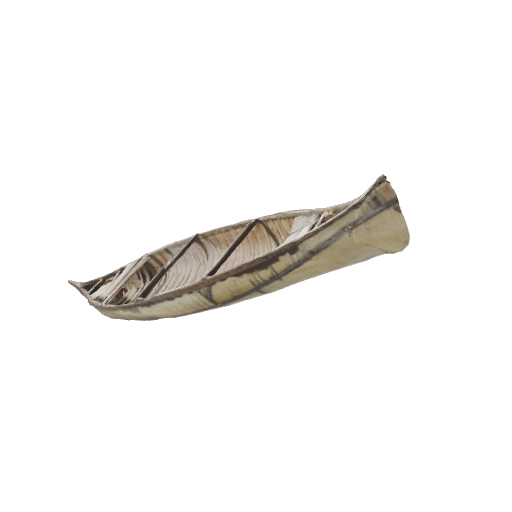Canoe
Wolastoqiyik: Oqiton, tul
Mi’kmaq: gisigu'lgw
The birch bark canoe is the Indigenous peoples’ preferred method of travel. Its shape is symmetrical and elongated, with a rounded bottom and pointed ends that curve upward. Its style and dimensions can vary. The Algonquian peoples make canoes adapted to the different uses and types of waterways travelled.
Typically, it takes two weeks for two people to craft a canoe. The first step is to find the right tree to supply the bark: straight birch tree of sufficient size and with flawless bark. The tree is then felled and stripped: this is usually done in the spring, when sap flows abundantly between the sapwood (trunk) and the bark. This makes it easier to remove the bark without damaging it, a process known as “bark peeling”. A temporary framework is then made to shape the canoe and mould the bark, which is then bent and held in place with stakes and stones. The gunwale, which forms the wooden rim at the opening of the canoe, is installed, and the bark is sewn onto it. The bark is then sealed and made waterproof with a tar produced by heating gum from fir, spruce or other softwood trees. Finally, the ribs, the thin pieces of wood that hold the canoe together at the bottom, are installed inside. These ribs are usually made of cedar and are bent by softening them with steam. As canoes are relatively vulnerable to shocks, they are repaired when damaged. They are often decorated with patterns or designs carved into the bark, especially on their tips.
The canoe is a fast, versatile, lightweight and very maneuverable means of transport. It can come ashore, be carried by a single person or cross rapids. It can accommodate one person or carry up to 12 people. However, navigators need to develop good balance since the canoe can easily capsize.
References
Date: Unknown
Origin: Causapscal, Québec
Owner: Site patrimonial de pêche Matamajaw. Causapscal.
Sources:
Gouvernement du Québec. (n.d.). Canoë d’écorce [Bark canoe]. Répertoire du patrimoine culturel du Québec. Retrieved September 10, 2022, from https://www.patrimoine-culturel.gouv.qc.ca/rpcq/detail.do?methode=consulter&id=216424&type=bien
Adney, E. T., & Chapelle, H. I. (1983). The Bark Canoes and Skin Boats of North America. Smithsonian.
Allard, M., & Ayrault, J. (with Zeitoun, J.). (n.d.). Fabrication de canot d’écorce [Crafting a bark canoe]. Inventaire des ressources ethnologiques du patrimoine immatériel. Retrieved September 10, 2022, from http://www.irepi.ulaval.ca/fiche-fabrication-canot-ecorce-960.html?from=home
Marsh, J. H. (2006, May 29). Birchbark Canoe. In The canadian encyclopedia. Retrieved April 20, 2022, from https://www.thecanadianencyclopedia.ca/en/article/birchbark-canoe
Marshall, I. (1984). Le canot de haute mer des Micmacs [Mi’kmaq high-sea canoe]. In C. A. Martin (dir.), Les Micmacs et la mer, (pp. 24–48). Recherches amérindiennes au Québec.
Canadian Museum of History. (n.d.). Bark canoes. In Wave Eaters; Bark Canoes [digital exhibition]. Retrieved September 10, 2022, from https://www.historymuseum.ca/cmc/exhibitions/aborig/watercraft/wab02eng.html
Canadian Museum of History. (n.d.). Algonquian bark canoes. In Wave Eaters; Bark Canoes [digital exhibition]. Retrieved April 20, 2022, from https://www.museedelhistoire.ca/cmc/exhibitions/aborig/watercraft/wab03fra.html
Jennings, J. E., & Adney, T. (2012). Bark Canoes: The Art and Obsession of Tappan Adney. Firefly Books.
